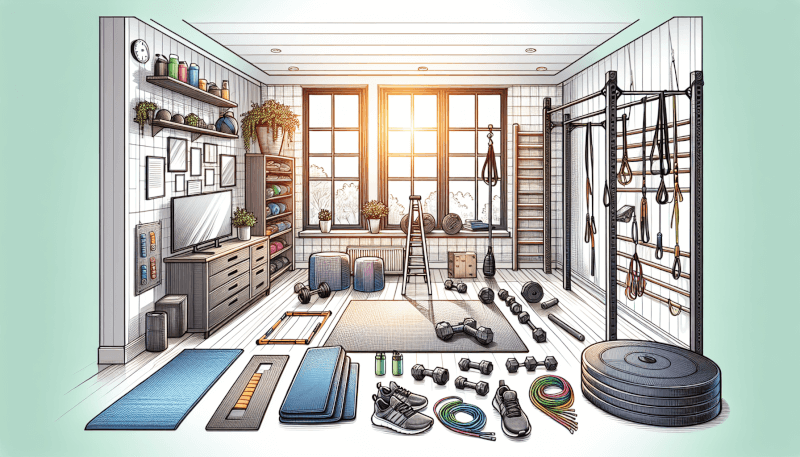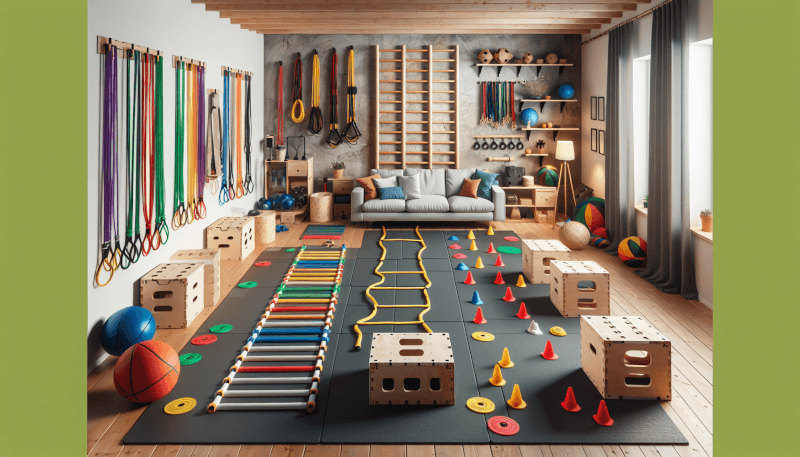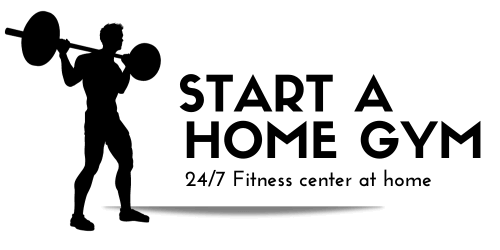Looking to enhance your speed and agility from the comfort of your own home? Look no further! In this article, we will explore 10 DIY home gym projects specifically designed to improve your speed and agility. From ladder drills to plyometric boxes, these projects are easy to make and will help you reach your fitness goals. So grab your tools and get ready to transform your home into a personal training haven!
DIY Gym Equipment
Have you ever wanted to improve your speed and agility but don’t have access to a fully equipped gym? Well, look no further! In this comprehensive guide, we will show you how to create your very own DIY gym equipment that will help you enhance your athletic performance. From agility ladders to resistance bands, we’ve got you covered. Get ready to transform your living space into a dynamic training ground!
Agility Ladder
An agility ladder is a fantastic tool to improve footwork, coordination, and overall agility. Creating your own agility ladder is simple and cost-effective. All you need are some basic materials like tape, rope, or even old bed sheets. By following the step-by-step instructions, you can have your very own agility ladder in no time. Get ready to take your speed and agility to the next level!
Plyometric Boxes
Plyometric exercises are essential for developing explosive power and increasing vertical jump height. Plyometric boxes are a must-have for performing exercises such as box jumps and tuck jumps. Building your own plyometric boxes is surprisingly easy and affordable. With a few simple tools and materials like plywood, screws, and wood glue, you can customize the height of your boxes to suit your fitness level. So, let’s dive into the step-by-step instructions and get those legs jumping!
Speed Sled
Do you want to enhance your acceleration and speed? A speed sled is a fantastic training tool that can help you achieve your goals. Unfortunately, professional speed sleds can be expensive. But fear not, because we have a DIY solution for you! Using materials like PVC pipes, a sled harness, and weights, you can create your very own speed sled at a fraction of the cost. Get ready to leave your competition in the dust with this budget-friendly DIY project!
Cones and Discs
Cones and discs are indispensable for speed and agility training. They can be used to create markers for drills such as shuttle runs, zigzag runs, and cone drills. Instead of purchasing expensive cones and discs, why not make your own? With materials like cardboard, markers, and tape, you can easily create your own customizable markers. So, let’s grab those materials and start crafting our very own training tools!
Resistance Bands
Resistance bands are versatile exercise tools that can add an extra challenge to your workouts. They are perfect for targeting various muscle groups and improving strength and flexibility. Don’t worry about spending money on expensive resistance bands – you can make your own! With just a few materials, like old bicycle inner tubes and a pair of scissors, you can create your very own resistance bands. Get ready to feel the burn with these cost-effective workout accessories!
Plyometric Exercises
Now that you have your DIY gym equipment ready, let’s delve into some effective plyometric exercises that will take your athleticism to new heights!
Broad Jumps
Broad jumps are a fantastic exercise for developing explosive leg power. Start by standing with your feet shoulder-width apart. Squat down, swing your arms back, and explode forward, jumping as far as you can. Land softly on your feet and immediately repeat the movement. Aim for three sets of ten jumps, resting for 30 seconds between sets. With consistent practice, you’ll notice significant improvements in your lower body strength and explosiveness.
Box Jumps
Box jumps are a staple in plyometric training and are excellent for building explosive power in your lower body. Stand facing a plyometric box or any sturdy elevated surface. With a slight bend in your knees, jump explosively onto the box, using your arms to drive the movement. Step down carefully and repeat the exercise for three sets of ten jumps, resting for 30 seconds between sets. Make sure to choose a box height that challenges you without compromising your safety. Get ready to feel the burn in your legs!
Medicine Ball Throws
Medicine ball throws are a fantastic full-body exercise that targets multiple muscle groups and improves overall power. Stand with your feet shoulder-width apart, holding a medicine ball at chest level. Squat down and explosively throw the ball forward as far as you can, using your hips, arms, and core muscles. Catch the ball, squat down again, and repeat for three sets of ten throws, resting for 30 seconds between sets. This exercise will not only improve your power but also enhance your coordination and stability.
Tuck Jumps
Tuck jumps are a challenging plyometric exercise that targets your quadriceps, glutes, and abdominal muscles. Stand with your feet hip-width apart, arms at your sides. Squat down slightly and explode upward, bringing your knees towards your chest as you jump. Land softly on your feet and immediately go into the next jump. Aim for three sets of ten jumps, resting for 30 seconds between sets. With consistent practice, you’ll notice improvements in your lower body strength, explosiveness, and core stability.
Lateral Bounds
Lateral bounds are excellent for increasing lateral explosiveness and improving balance and stability. Start by standing parallel to a line or any marked area. Jump explosively sideways, landing on the opposite leg. Immediately jump back to the starting position and repeat on the other side. Aim for three sets of ten lateral bounds on each side, resting for 30 seconds between sets. With regular practice, you’ll notice improvements in your lateral movement and agility.

Speed Training Drills
Now that you have built your own DIY gym equipment and mastered some plyometric exercises, it’s time to focus on speed training drills. These drills will help you improve your acceleration, top speed, and overall quickness.
Shuttle Runs
Shuttle runs are a classic speed training drill that improves acceleration, deceleration, and quick changes of direction. Set up two markers approximately 10-20 yards apart. Start at one marker and sprint to the other, touching the ground or a marker with your hand. Immediately change direction and sprint back to the starting point. Repeat this back and forth movement for three sets of ten runs, resting for 30 seconds between sets. Say goodbye to sluggishness and hello to lightning-fast speed!
Sprint Intervals
Sprint intervals are an effective training method to improve your cardiovascular fitness and speed. Find a flat stretch of ground approximately 100 meters long. Start at one end and sprint as fast as you can to the other end. Slow down to a walk or light jog, allowing yourself to catch your breath. Repeat this sprint-walk/jog cycle for three sets of five intervals, resting for 30 seconds between intervals and 60-90 seconds between sets. With consistent practice, you’ll notice improvements in your overall speed and endurance.
Dot Drills
Dot drills are fantastic for developing quickness, coordination, and agility. Use your DIY cones or discs to create a series of dots in various directions. Start by standing on two feet, then jump forward, backward, and sideways onto each dot as quickly as possible. Repeat the routine for three sets of ten jumps in each direction, resting for 30 seconds between sets. The more you practice dot drills, the better your footwork and reaction time will become.
Hill Sprints
Hill sprints are a challenging yet effective speed training drill that targets your leg muscles and improves your running technique. Find a hill with an incline that challenges you but is not too steep. Start at the bottom of the hill and sprint as fast as you can to the top. Walk or jog back down to recover, then repeat the sprint for three sets of ten sprints, resting for 30 seconds between sets. Hill sprints are a great way to build explosive power and endurance in your lower body.
Wind Sprints
Wind sprints are an intense speed training drill that mimics the demands of high-intensity sport situations. Set up markers approximately 60-100 meters apart in a straight line. Start at one marker and sprint as fast as you can to the next one. Slow down to a walk or light jog, allowing yourself to catch your breath. Repeat this sprint-walk/jog cycle for three sets of five sprints, resting for 30 seconds between sprints and 60-90 seconds between sets. Get ready to push your limits and unleash your inner speed demon!
Agility Training Exercises
Agility training exercises are crucial for athletes who need quick reflexes, lateral movement, and overall agility. Let’s explore some exercises that you can incorporate into your training routine.
Ladder Drills
Ladder drills are excellent for improving footwork, coordination, and quick changes of direction. Use your DIY agility ladder and complete exercises such as ladder hops, lateral shuffles, and quick feet. Aim for three sets of ten repetitions for each exercise, resting for 30 seconds between sets. With consistent practice, you’ll notice improvements in your speed, agility, and overall footwork.
Cone Drills
Cone drills are a staple in agility training and are perfect for improving your ability to quickly change direction. Set up your DIY cones in various patterns such as the T-drill, 3-cone drill, or star drill. Complete these drills by quickly running around the cones, making sharp turns, and accelerating out of each maneuver. Aim for three sets of ten repetitions for each drill, resting for 30 seconds between sets. Cone drills will challenge your coordination, speed, and agility.
5-10-5 Agility Drill
The 5-10-5 agility drill, also known as the short shuttle, is a fantastic way to improve your lateral speed and quickness. Set up three markers in a straight line, with the first and third markers 5 yards apart and the middle marker 10 yards away. Start straddling the middle marker and sprint to touch the first marker, then sprint back and touch the third marker. Complete three sets of ten repetitions, resting for 30 seconds between sets. This drill will enhance your ability to change direction rapidly and explosively.
Reaction Ball Exercises
Reaction ball exercises are excellent for developing hand-eye coordination, reaction time, and overall agility. Throw a reaction ball against a wall and quickly react to its unpredictable bounce. Try to catch the ball or return it with a specific hand or body part. Repeat this exercise for three sets of ten throws, resting for 30 seconds between sets. Reaction ball exercises will improve your reflexes and enhance your ability to respond quickly to unexpected situations.
Zigzag Runs
Zigzag runs are a challenging agility exercise that improves your lateral movement, coordination, and speed. Set up your DIY cones or discs in a zigzag pattern, approximately 10-20 yards apart. Start at one end and sprint towards the first cone, then quickly change direction and sprint towards the next cone diagonally. Continue this zigzag pattern until you reach the end. Aim for three sets of ten repetitions, resting for 30 seconds between sets. Zigzag runs will challenge your ability to change direction quickly and maintain speed.

DIY Plyometric Boxes
Building your own plyometric boxes is both cost-effective and satisfying. Follow these step-by-step instructions to create your very own customizable plyometric boxes.
Materials Needed:
- Plywood (3/4 inch thick)
- Screws
- Wood glue
- Measuring tape
- Saw
- Screwdriver
- Sandpaper
Step-by-Step Instructions:
Measure and mark the desired dimensions for your plyometric boxes. The most common sizes are 12 inches, 18 inches, and 24 inches in height, but feel free to customize to your fitness level and preferences.
Using a saw, carefully cut the plywood according to your marked dimensions. Make sure to smooth out any rough edges using sandpaper.
Take two of the cut plywood pieces that will form the sides of the box. Apply wood glue to the edges and connect the pieces, forming a right angle. Use screws to secure the joint, ensuring stability.
Repeat the previous step with the remaining plywood pieces, creating three more sides for the box. Once all the sides are connected, apply wood glue to each joint and reinforce them with screws.
Allow the wood glue to dry completely, following the instructions on the packaging.
Once dry, your plyometric box is ready for use! You can also paint or varnish it to add a personal touch.
Remember, safety is essential when using plyometric boxes. Always ensure the boxes are stable and secure before attempting any exercises. Start with lower heights and gradually increase as your strength and confidence improve.
DIY Agility Ladder
Creating your own agility ladder is a fun and budget-friendly way to enhance your footwork and coordination. Here’s a simple guide for crafting your DIY agility ladder.
Materials Needed:
- Tape (masking or duct tape)
- Rope or old bed sheets
Step-by-Step Instructions:
Measure the desired length of your agility ladder. A standard agility ladder typically measures 15-20 feet long, but feel free to customize it to your available space.
Cut the rope or bed sheets into equal-length segments based on your desired ladder width. The most common width is 16-20 inches, but you can adjust according to your preferences.
Lay the rope or bed sheet segments on the ground, parallel to each other, with equal spacing. Ensure they are straight and taut.
Using tape, secure the rope or bed sheet segments to the ground at each end. Make sure to press the tape firmly to ensure it adheres properly.
Repeat the previous step for each segment, ensuring they are evenly spaced and securely attached.
Your DIY agility ladder is now ready to use! Place it on a flat surface and start performing ladder drills to improve your footwork, speed, and agility.
Remember to perform exercises with proper form and technique to maximize the benefits of the agility ladder. Be mindful of your foot placement and maintain a high tempo during drills to challenge your coordination and reaction time.

DIY Speed Sled
A speed sled can significantly improve your acceleration and speed. Building your own speed sled is a cost-effective alternative to purchasing an expensive one. Here’s a step-by-step guide to creating your own DIY speed sled.
Materials Needed:
- PVC pipes (1-1.5 inches in diameter and 4-6 feet in length)
- Sled harness
- Weights or sandbags
- Screws
- Screwdriver
Step-by-Step Instructions:
Measure and mark the desired length for your speed sled using the PVC pipes. The most common length is 4 feet. If you prefer a longer sled, you may need to purchase longer PVC pipes.
Using a saw, carefully cut the PVC pipes to your marked length. Make sure to smooth out any rough edges.
Lay the PVC pipes parallel to each other, approximately shoulder-width apart.
Attach the sled harness to the PVC pipes, ensuring a secure connection. Follow the instructions provided with the harness for proper attachment.
Place weights or sandbags on top of the sled harness to create resistance. Start with a manageable weight and increase gradually as your strength improves.
Secure the weights or sandbags to the sled harness using screws. This will prevent them from shifting during your training sessions.
Your DIY speed sled is now ready to use! Find a flat surface or a grassy area to perform sled sprints and improve your acceleration and speed.
Always use caution and start with lighter weights to avoid straining yourself. Gradually increase the weight as your strength and conditioning progress. Focus on explosive movements while pushing the sled, and remember to maintain proper form throughout the exercise.
DIY Cones and Discs
Cones and discs are essential for many speed and agility training drills. Creating your own cones and discs is not only cost-effective but also allows you to customize their size and color. Follow these simple instructions to make your DIY cones and discs.
Materials Needed:
- Cardboard
- Markers (permanent or acrylic)
- Tape
Step-by-Step Instructions:
Cut the cardboard into circular or triangular shapes, depending on whether you want cones or discs.
Use the markers to color the cones or discs. You can choose different colors to differentiate between drills or simply make them visually appealing.
Apply tape to the base of each cone to enhance stability and durability. This will prevent them from collapsing during training sessions.
Your DIY cones and discs are now ready to use! Set them up in various patterns to perform drills such as shuttle runs, cone drills, and zigzag runs.
Feel free to get creative with your designs and decorations. You can add patterns, numbers, or even motivational quotes to personalize your cones and discs. With these DIY training tools, you’ll be ready to tackle any speed and agility drill!

DIY Resistance Bands
Resistance bands are versatile exercise tools that can take your workouts to the next level. Building your own resistance bands is an easy and cost-effective alternative to purchasing expensive ones. Here’s a step-by-step guide to creating your DIY resistance bands.
Materials Needed:
- Old bicycle inner tubes (thick and durable)
- Scissors
Step-by-Step Instructions:
Lay the old bicycle inner tube flat on the ground.
Using the scissors, carefully cut the inner tube into bands of different lengths and widths. The lengths you choose will depend on the exercises you plan to perform and the resistance level you desire.
Test the resistance of each band by stretching it. If you need more resistance, you can double or triple the bands.
Your DIY resistance bands are now ready to use! Incorporate them into your workouts to target various muscle groups and enhance your strength and flexibility.
Remember to use proper form during exercises and choose the appropriate resistance level for each movement. Gradually increase the resistance as your muscles become stronger. With consistent training, your DIY resistance bands will become an indispensable part of your fitness routine.
Safety Tips
While DIY gym equipment and training exercises can be effective, it’s important to prioritize safety. Here are some essential safety tips to keep in mind during your speed and agility training sessions.
Clearing the Exercise Area
Ensure that the area where you will be training is clear of any obstacles or hazards. Remove any loose objects, sharp edges, or slippery surfaces that may cause potential injuries. Having a clear exercise area will minimize the risk of accidents and allow you to focus on your training.
Proper Warm-up and Stretching
Always start your training sessions with a thorough warm-up and stretching routine. This will increase blood flow to your muscles, improve flexibility, and reduce the risk of injury. Incorporate dynamic stretches and movements that mimic the exercises you will be performing. Remember to cool down and stretch again after your workout to aid in muscle recovery.
Using Spotter/Partner
When performing exercises that involve heavy weights or a high risk of injury, it’s beneficial to have a spotter or training partner. They can provide assistance, ensure proper form, and offer support during challenging exercises. If you don’t have a spotter, make use of safety precautions such as using safety bars or adjusting the weights to a manageable level.
Gradual Progression
It’s essential to progress gradually when it comes to intensity, duration, and difficulty of exercises. Start with lighter weights, shorter intervals, and less complex movements. As your fitness level improves, you can gradually increase the challenge. Pushing too hard too soon can lead to overuse injuries or burnout, so be patient and listen to your body.
Listening to Your Body
One of the most important safety tips is to listen to your body. Pay attention to any signs of pain, discomfort, or fatigue during your training sessions. If something doesn’t feel right, stop and assess the situation. Pushing through pain or ignoring warning signs can lead to injuries. Rest and allow your body to recover when needed. Always prioritize your safety and well-being above all else.
By following these safety tips and exercising caution, you can enjoy your DIY gym equipment and training exercises while minimizing the risk of injury. Remember, training safely is the key to long-term progress and success.
In conclusion, with these DIY gym equipment and training exercises, you now have everything you need to improve your speed and agility right from the comfort of your own home. From the agility ladder to the resistance bands, you can create your very own training arsenal without breaking the bank. Just remember to prioritize safety, start at your own pace, and gradually increase the intensity. In no time, you’ll be boosting your athletic performance and reaching new levels of speed and agility. Happy training!



